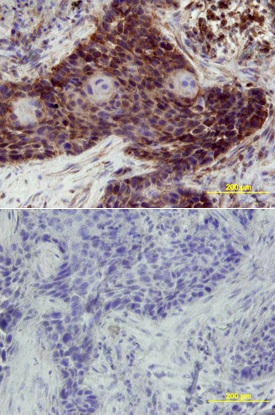Human ErbB3/Her3 Antibody Summary
Asn953-Gly1090
Accession # P21860
Applications
Please Note: Optimal dilutions should be determined by each laboratory for each application. General Protocols are available in the Technical Information section on our website.
Scientific Data
 View Larger
View Larger
ErbB3/Her3 in Human Lung. ErbB3/Her3 was detected in immersion fixed paraffin-embedded sections of human lung array using Mouse Anti-Human ErbB3/Her3 Monoclonal Antibody (Catalog # MAB3483) at 15 µg/mL overnight at 4 °C. Tissue was stained using the Anti-Mouse HRP-DAB Cell & Tissue Staining Kit (brown; Catalog # CTS002) and counterstained with hematoxylin (blue). Lower panel shows a lack of labeling if primary antibodies are omitted and tissue is stained only with secondary antibody followed by incubation with detection reagents. View our protocol for Chromogenic IHC Staining of Paraffin-embedded Tissue Sections.
Reconstitution Calculator
Preparation and Storage
- 12 months from date of receipt, -20 to -70 °C as supplied.
- 1 month, 2 to 8 °C under sterile conditions after reconstitution.
- 6 months, -20 to -70 °C under sterile conditions after reconstitution.
Background: ErbB3/Her3
ErbB3, also called Her3 (human epidermal growth factor receptor 3), is a type I membrane glycoprotein that is a member of the ErbB family of tyrosine kinase receptors. ErbB family members serve as receptors for the epidermal growth factor (EGF) family of growth factors. Among ErbB family members, ErbB3 is unique in that it contains a defective kinase domain. ErbB3 is expressed in keratinocytes, melanocytes, skeletal muscle cells, embryonic myoblasts and Schwann cells. Monomeric ErbB3 serves as a low affinity receptor for the heregulins (HRG). ErbB3 heterodimerizes with ErbB2 to form a high affinity receptor complex. In contrast, ErbB3 homodimerization or heterodimerization with ErbB4 forms a low affinity heregulin-binding complex. Because ErbB3 contains a defective kinase domain, the kinase domain of ErbB2 is responsible for initiating the tyrosine phosphorylation signal through the heterodimeric receptor. It has been found that a discrete three amino acid signal in the ErbB3 cytoplasmic domain is critical for transactivation of ErbB2. The cytoplasmic domain of ErbB3 also contains six consensus binding motifs for the SH2 domain of the regulatory p85 subunit of phosphoinositide 3-kinase (PI 3-kinase, PI3K) as well as one proline-rich consensus binding motif for the SH3 domain of p85. Human ErbB3 consists of 1342 amino acids (aa) with a 19 aa signal sequence, a 624 aa extracellular domain, a 21 aa transmembrane region, and a 678 aa cytoplasmic domain. ErbB3 appears to play roles in development, cancer, communication at the neuromuscular junction and regulation of cell growth and differentiation.
- Kraus, M.H. et. al. (1989) Proc. Natl. Acad. Sci. 86:9193.
- Plowman, G.D. et. al. (1990) Proc. Natl. Acad. Sci. USA 87:4905.
- Carraway, K.L. 3rd et. al. (1994) J. Biol. Chem. 269:14303.
- Emkey, R. and C.R. Kahn (1997) J. Biol. Chem. 272:31172.
- Sundaresan, S. et. al. (1998) Endocrinology 139:4756.
- Hellyer, N.J. et. al. (1998) Biochem. J. 333:757.
- Schaefer, G. et. al. (1999) J. Biol. Chem. 274:859.
- Hellyer, N.J. et. al. (2001) J. Biol. Chem. 276:42153.
- Schlessinger, J. (2000) Cell 103:211.
- Daly, R.J. (1999) Growth Factors 16:255.
Product Datasheets
FAQs
No product specific FAQs exist for this product, however you may
View all Antibody FAQsReviews for Human ErbB3/Her3 Antibody
There are currently no reviews for this product. Be the first to review Human ErbB3/Her3 Antibody and earn rewards!
Have you used Human ErbB3/Her3 Antibody?
Submit a review and receive an Amazon gift card.
$25/€18/£15/$25CAN/¥75 Yuan/¥2500 Yen for a review with an image
$10/€7/£6/$10 CAD/¥70 Yuan/¥1110 Yen for a review without an image




